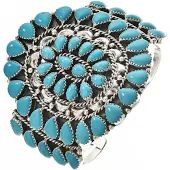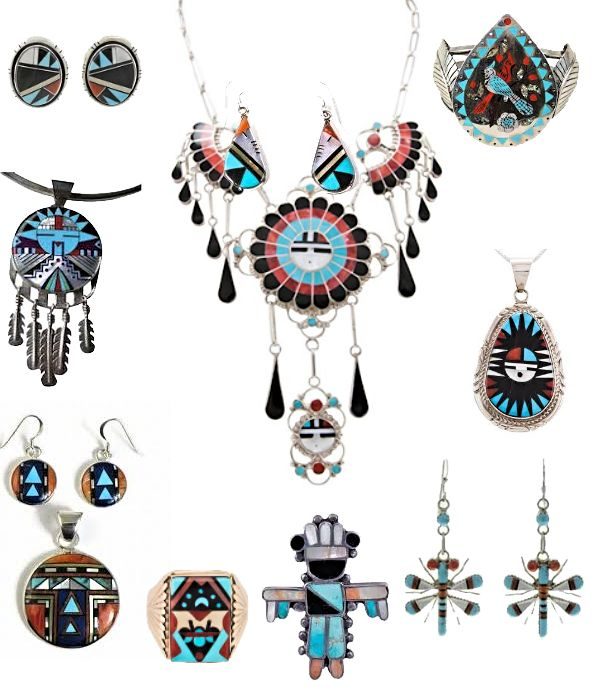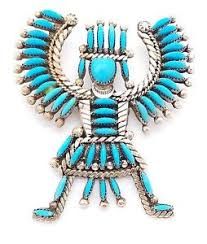Metalworking had a different history among the Zuni than that of the Navajo and Hopi. In about 1830, the Zuni learned to work with copper and brass salvaged from old kettles. They did not begin silver crafting until four decades later.

Zuni Petit Point Bracelet
The Zuni people are in a way a mysterious tribe. Their culture is very reclusive and isolated much as is their city and their language. They are an interesting people who are well known for their beautiful artwork, sculpture, weavings and jewelry.
Many years ago, the Zuni people came up to this Earth from the underworld at a place that is identified as either the Grand Canyon or the Mojave Desert. They call the area where they live as the center or middle place.
The Zuni are thought to be direct descendants of the Anasazi. While many anthropologists believe that the Zuni are related to the other pueblo tribes that are scattered throughout the Southwest, they are unique in that their language, to this day, is only spoken by them and bears no resemblance to the languages of any of the other surrounding tribes. Their language is often called Zunian.
According to Zuni cosmology, everything in the universe from natural forces such as lighting, wind, or great droughts, to physical entities, such as rocks, animals, rivers, and human beings has its own spirit. Each of these spirits has the power to observe, think, and respond to humankind.
An inanimate object, such as a rock or a lump of dirt, is believed to possess a spirit similar to that of a hibernating bear or a seed that has not yet been planted. The power is simply dormant, for the moment.
For the traditional Zuni, a fetish is just one aspect of a complex religion whose central goal is to achieve a balance with nature. Throughout the Zuni religion, there is great reverence for the unseen world and the mysterious forces that continue to impact on all life.
There are twelve shamanistic societies. These not only treat sickness but participate as societies and perform feats of wonder for the people, each has several orders or degrees and each order is the custodian of some secret of healing or magic.
Around 1872, the Navajo smith Atsidi Chon, who traded frequently with the Zuni for livestock, taught a Zuni blacksmith named Lanyade the skill of silversmithing. Much of the earliest Zuni silver jewelry was essentially identical to Navajo work.
Early Zuni Indian jewelry-making efforts often took the form of collaborations between Navajos and Zuni Indians, in which a Navajo smith would cast a silver piece -by sandcasting or another method- and a Zuni Indian lapidarist would set in the stones.
Early Zuni pieces were plain, hand-wrought silver occasionally decorated with simple die-stamping or rocker engraving. Around 1890 they began to include turquoise in their work, as had their Navajo neighbors.

Zuni Inlaid Jewelry
The emphasis on small stone work and inlay work began to emerge in the 1920s, developing partly from a revival of prehistoric designs. The Zuni have long been masters of the lapidary arts. The Zuni Native Americans were creating bead jewelry and fancy shell pendants with mosaic stone inlay on them even in ancient times.
Until about 1920, the Zuni fashioned jewelry primarily for themselves and other native peoples. By 1930, the Zuni were creating much of their jewelry for tourists. Within ten years, jewelry making had become a major source of revenue for Zuni artists.
The pueblo of Zuni Native American Indians is located in western New Mexico (south of Gallup) near the Arizona border. Today, jewelry-making is the major craft industry of the village.
The Zuni do three types of intricate jewelry, one of which is called petit point (tiny round, oval or square stones laid individually in an intricate pattern), another is Needle Point jewelry (tiny needle shaped stones laid individually in an intricate pattern), and the last style is Inlay Jewelry (tiny pieces of stone carefully fit together and inlaid in silver channels.
Petti Point and Needlepoint are identified by tiny stones (usually turquoise or coral) each supported in their own bezel. It’s extremely time consuming to make and is very delicate in appearance.
The Zuni Indians focus on stone cutting, they make simplistic silver pieces to accommodate their fabulous stonework.
Today, these styles of jewelry- needlepoint, petit point, and inlay – are most strongly associated with the Zuni jewelry making tradition. However, some Navajo, who are usually associated with larger beveled stones in their natural shape, also make jewelry in these styles.
The other type of jewelry associated with the Zuni is called Inlay. Here again, stones are worked and then fit together, sometimes side by side, or with silver channels in between them, known as channel inlay. Zuni Indians focus on stone cutting. They make simplistic silver pieces to accommodate their fabulous stonework.
Each piece is meticulously fabricated; the Zunis do not cast the silver. The predominant colors and stones used in traditional Zuni inlay are turquoise, coral, jet, and white mother of pearl. Symbolically red represents the Mother Earth, and turquoise Father Sky. Turquoise was discovered over 7.500 years ago and it was believed to have come from the heavens.
The making of inlaid jewelry is quite different than conventional methods of jewelry making. A silver and/or goldsmith first makes the metal creation with channels to accommodate a stone or group of stones.

Zuni Needlepoint Pin
The jewelry item is then inlaid with gemstones by cutting the stones to fit into a channel or void/recess in the metal. They are glued in with epoxy, then ground, sanded and polished. In the traditional practice, the stones are sanded flat or even with the metal.
If an artist is creating a “corn row” or “cobble stone” piece, the stones are cut before they are inlaid into the piece of jewelry.
Zuni Native American artists favor the color combonation of Turquoise, Coral and Mother of Pearl, but Zuni Silversmiths make jewelry in all diffferent colors. Zuni needlepoint jewelry is usually done in a single color or gemstone.
Zuni artists are known for their attention to detail. They are also known for thier expert lappidary skills in cutting the stones.
Most of the Zuni Needlepoint Jewelry is light and easy to wear.
